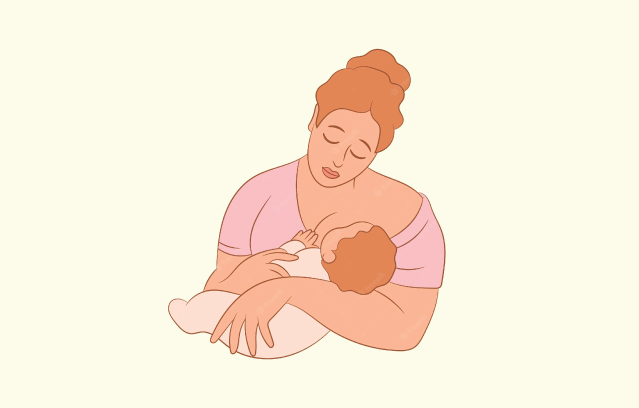
Why do humans drink so much milk? Thanks to nature this is the first source of nutrition that is available right from birth. Milk is the first complete source of nutrition for newborns. It contains all the essential nutrients for growth and development like proteins, carbohydrates, fats, and vitamins. This is in fact the only thing that the baby should ingest after birth for six months. Mammary glands are responsible for the production of milk in the female body. Breastfeeding is an experience and the beginning of motherhood. This is the first step toward the baby’s nutrition. But remember not to be over-pressurized with this fact and being a mum takes it easy!
Breastfeeding baby
How long should I breastfeed the baby?
According to the lactational experts, mum should feed the baby for the next 6 months. Then other food items should be included after this. Remember every baby is different and thus this will depend on your baby’s needs. It’s important to keep in mind the first 6 months. Gynaecologist specialists can tell you how much you should feed your baby.
How much should I breastfeed the baby?
According to physiology, breastfeed is divided into the first week, first 6 months and 6-12 months. It varies according to the demand of the baby but there is a common pattern that is observed.
First few days the baby : In every 1-3 hour gap your baby is hungry and needs milk. This is essential to meet the baby’s nutritional requirements as well as immunological needs. This is the time when your baby will get habitual of breastfeeding. You as a new mum will learn a lot more things about the nutrition of your child.
First week and months can be very demanding as a mum. You need to take care of your nutrition in the best possible way. This time the baby will demand for more frequent breastfeeding, every 2-4 hours. This is important that your baby needs nutrition, milk enriched with calories to satisfy energy needs.
6-12 months of breastfeeding can be a little tiring for you. But don’t worry the demand and frequency of milk intake will decrease. This can be decreased by including other nutritional food items.
12-14 months breastfeeding is totally based on your baby’s needs. Shift from breastfeeding to a solid diet is evidently marked.
Types of breast feeding position
It is observed that mothers naturally know the art of breastfeeding but in some particular cases gynaecologists have to take special care and give attention to mothers for breastfeeding. It’s important to hold the baby in the right position otherwise it can lead to indigestion and other gastric problems. A proper assistance from your gynaecologist can help you hold your baby in perfect position. One thing you should always keep in mind is that being a mother you should always sit in a comfortable position for breastfeeding. Here are some common positions.
Cradle position
It is the most common position for breastfeeding. Cradle means a pot or bed for the baby. So this is the position one can easily keep. This will support the baby’s head against your breast and will keep you in a comfortable position.
Cross-Cradle position
Just change the hand and support the baby’s head with your hand instead of your breast. In this position you can easily guide the baby towards the breast.
Clutch position
In this position the baby is to your side and is held in one hand. You can talk to your gynaecologist about this position if the above positions don’t suit you. It will lower the weight on your abdomen and is beneficial for caesarean.
Side-lying position
In this position the mother lies on the bed with a pillow for back and neck support. This is another position for women who have undergone caesarean section.
Being a new mum it’s important to know the position for breastfeeding. This will help you in comfortable breastfeeding. Consult your gynaecologist to find the most comfortable position for you and your baby!
What are the stages of breastfeeding
According to the American Pregnancy Association breast milk has three stages: colostrum milk, transitional milk and mature milk. These stages are explained as follows:
Colostrum milk : It’s an immunity booster dose for your child, it contains immunoglobulins, proteins, carbs and vitamins. It’s there for a few days after the birth of your child. It’s generally creamy and yellowish compared to breast milk produced later. Colostrum is also called first milk and is necessary for a baby just after the birth as it provides immunity from the exterior environment right after the birth. It’s seen in many cases that a child is likely to get an infection if colostrum is not provided after the birth. This is followed by normal breast milk and the next stage: transitional stage.
Transitional milk : This stage lasts for approximately two weeks. It’s important to note that it contains a higher amount of calories, fats and lactose. Compared to colostrum it has a higher amount of water soluble vitamins.
Mature milk : It is further divided into fore-milk and hind-milk. This contains the highest amount of water to keep your baby hydrated. It contains 10% of nutrients like proteins, carbohydrates and calories for optimum energy. Fore-milk is the initial release of milk from the mammary gland and contains mostly water while the other hind-milk is the later release of milk which contains all the nutrients specially fats and calories for energy.
Breastfeeding problems
Are you having sore nipples or lack of milk? Consult your midwife or gynaecologist as soon as you notice sore nipples. In the majority of mums sore nipples develop due to improper positioning of your baby or lack of attachment to breast. Make sure to follow the proper breastfeeding position.
Not enough breast milk or complete lack of milk is another common problem that women face these days. This could be due postpartum stress or some underlying disorder. It is advised to alternate the breast during breast feed to make sure proper milk.
Breast engorgement occurs when the breast is completely full and it is painful. It can occur in babies who just started breastfeeding or babies who are now on a solid diet. If breast engorgement is too often apart from the mentioned, the reason could be improper breastfeeding.
Breastfeeding is a new practice for your and your baby. It will take a few days for each of you to adapt to it. Make sure to visit the gynaecologist clinics or meet gynaecologists through online consultation because breastfeeding is a miracle!
Don’t and do’s of breastfeeding
Breast milk is the best milk! Don’t try to replace it with other milk bottles. No sugars in form jaggery or honey before first breast milk
Don’t smoke or drink during breastfeeding. This can be toxic for babies.
If possible make the baby burp. This will ensure proper digestion of the child.
Keep your body well hydrated. This will ensure proper nutrients like proteins and carbs.
Do get your vaccines specially for influenza and measles.
Don’t discontinue breastfeeding until you are too sick. Keep pumping!
Don’t freak out when your milk comes out. Take your time.
Intake of drugs can interfere with your baby’s brain growth.
It’s okay to discontinue breastfeeding and don’t feel bad about it. You are not a bad mother. Take help of your gynecologist for best possible alternatives.


